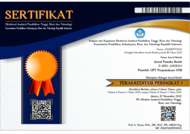REVITALISASI PERAN PERPUSTAKAAN UMUM BAGI MASYARAKAT
Abstract
The positive development of the various plans of the central government and local government in revitalizing the function of the library in the middle of the community deserve an immediate response by the relevant stakeholders in librarianship. This avoids the loss of state spending because of the development budget of the library, while the library can not be used optimally by the community. In addition to causing harm to the state budget, the failure of the revitalization of the public library functions have an impact on the loss of public confidence in the library. See some interesting phenomenon, the author argues that it is time the library needs to revitalize its role for the community. The issue raised is how the shape of revitalizing the role of the public library for the community.
There are several factors driving the revitalization of the role of libraries, namely
the advancement of information and communication technologies, the increasing
mobility of educated people and high society. The revitalization of the role of public libraries include the library as a social change agent, the agent of human development and cultural agents. Revitalization activities the library’s role as change agents are providing a variety of programs that present a public library, according to the dynamics of today’s society, setting up community-based public library. Revitalize the role of the public library into a public space as a catalyst for social activities, recreation, and culture of the citizens, and to make the library more dynamic, practical and humane. Revitalizing the role of the public library as part of a public service by applying the standard ISO 9008: 2008 in libraries, innovation bureaucracy and library services, as well as professional certification library manager.
Keywords
Full Text:
PDFReferences
Asmiyanto, Taufik. 2005. “Eksistensi Perpustakaan di Era Reformasi: Pendapat Kritis”. Makalah, Rakerpus dan Seminar Ilmiah IPI XIII Pekanbaru, Riau, 31 Mei - 3 Juni 2005, Pekanbaru:IPI, 2005, 11 pg. Dian Sinaga. 2004. “Perpustakaan Umum Di Indonesia Sebagai Agen Dari Perubahan Social”.Jurnal Sosiohumaniora, 6 (1), Maret 2004. Echols, John M., & Shadily, Hasan. 1992. Kamus Inggris - Indonesia. Jakarta: Gramedia Pustaka Utama. http://bisnis.tempo.co. 2016. perpustakaan-100-m-terbaik-dan-terbesar-di-indonesia (accessed January 5, 2016). Junaenah, Siti. 2014. “Revitalisasi Perpustakaan Umum menjadi Dinamis, Praktis, dan Humanis”.Dalam Tri Hardiningtyas, dkk. (Editor), Bunga Rampai Membangun Perpustakaan Ideal,131-139. Yogyakarta: Smart WR. Kartika D., Indah. 2010. “Perpustakaan Umum Surakarta sebagai Perwujudan Ruang Komunikasi dengan Pengoptimalan Pengolahan Lansekap”. Skripsi, Fakultas Teknik UNS, Surakarta. Kementrian Menpan RB. 2014. Top inovasi Pelayanan Publik Indonesia Tahun 2014. Jakarta:Kementrian Menpan RB. Nurtakyidah. 2013. “Inovasi-inovasi Perpustakaan Abad 21”. Jurnal Iqra, 7 (1), hlm: 30-41. Mei,2013. Ridarineni, Neni. www.republika.co.id. Desember 05, 2015. www.republika.co.id (accessed Mei 24, 2016). Undang-Undang Republik Indonesia Nomor 43 Tahun 2007 tentang Perpustakaan. Zulaikha, Sri Rohyanti. 2008. “Kontribusi SR Ranganathan dalam Perkembangan ilmu Perpustakaan Dewasa Ini”. Fihris, 3 (1) Januari - Juni, 2008: 8 pg.
DOI: https://doi.org/10.20961/jpi.v2i1.33180
Refbacks
- There are currently no refbacks.




.png)
.png)









1.jpg)
